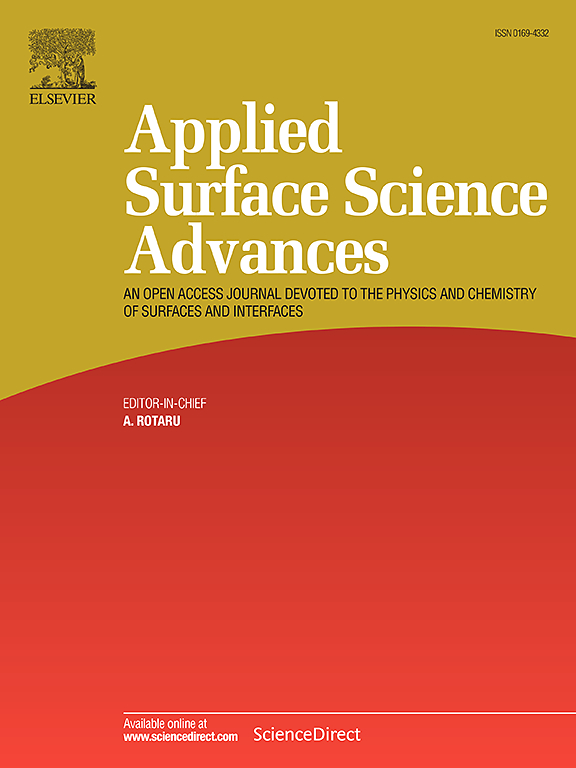Greener, safer, and stronger: plasma ion-exchanged pharmaceutical glass vials for precision drug delivery dosing
IF 8.7
Q1 CHEMISTRY, PHYSICAL
引用次数: 0
Abstract
This study introduces the groundbreaking synergistic influence of plasma and ion-exchange treatment (P-IET), conducted under varying conditions at temperatures of 450 °C and 500 °C for 2, 12, and 24 h, preceded by a few seconds of pre-plasma treatment using a mixed air-argon gas approach. P-IET is a cost-effective, innovative, long-lasting, and industrially scalable process designed to improve the performance of Type I borosilicate glass across various pharmaceutical packaging forms and structures. This treatment produces a durable hydrophilic surface, as confirmed by FTIR analysis, which shows a broad and intense OH group peak at ∼3350 cm⁻¹, along with significant structural changes demonstrating enhanced water-attractive properties. Furthermore, P-IET significantly lowers water contact angles on the glass's inner surface, amplifying its hydrophilicity. These improvements are crucial for water-based drug formulations, facilitating efficient and waste-free drug delivery by enabling complete withdrawal and precise dosing—critical features and requirements for contemporary and modern pharmaceutical applications. This level of performance is crucial for ensuring safety and reducing waste associated with expensive and highly sensitive medications, including cytotoxic therapies and anticancer treatments.
Beyond hydrophilicity, P-IET also significantly enhances the mechanical strength of glass by generating a robust compressive layer, hence doubling its resistance to crushing loads by 2124 ± 21 N (e.g., at 500 °C for 24 h) compared to untreated standard vials available on the market today, which have a resistance 1157 ± 91 N. Moreover, P-IET sterilizes the glass surface by removing biological contaminants, microorganisms, and organic residues and improves chemical durability by reducing Na and K ion leach-out, thus assuring long-term chemical stability under various pH conditions. Notably, these are achieved without changing the colour or transparency of the glass vials with preserving their aesthetic or functional integrities. The proposed transformative technology addresses critical challenges in pharmaceutical packaging by introducing a greener, safer, and highly effective solution. P-IET enables the complete withdrawal of medications with precise dosing and boasts exceptional mechanical and chemical resistance. This innovation sets new standards and benchmarks for Type I borosilicate glass while promoting the development of novel drug delivery systems distinguished by their unique reliability and sustainability.

更环保,更安全,更强:等离子离子交换药用玻璃瓶精确给药剂量
本研究介绍了等离子体和离子交换处理(P-IET)的开创性协同影响,在450°C和500°C的不同条件下进行2,12和24小时,然后使用混合空气-氩气方法进行几秒钟的预等离子体处理。P-IET是一种具有成本效益,创新,持久和工业可扩展的工艺,旨在提高I型硼硅酸盐玻璃在各种药品包装形式和结构中的性能。这种处理产生了持久的亲水表面,正如FTIR分析所证实的那样,在~ 3350 cm处有一个广泛而强烈的OH基团峰,伴随着显著的结构变化,显示出增强的水吸引特性。此外,P-IET显著降低了玻璃内表面的水接触角,增强了其亲水性。这些改进对水基药物配方至关重要,通过实现完全停药和精确给药,促进有效和无废物的药物输送——这是当代和现代药物应用的关键特征和要求。这种水平的性能对于确保安全性和减少与昂贵和高度敏感的药物(包括细胞毒性疗法和抗癌治疗)相关的浪费至关重要。除了亲水性,P-IET还通过产生坚固的压缩层显着提高了玻璃的机械强度,因此与目前市场上未经处理的标准瓶相比,其抗压载荷增加了2124±21 N(例如,在500°C下24小时),其抗压能力为1157±91 N。此外,P-IET通过去除生物污染物,微生物,并通过减少Na和K离子的浸出来提高化学耐久性,从而保证在各种pH条件下的长期化学稳定性。值得注意的是,这些都是在不改变玻璃小瓶的颜色或透明度的情况下实现的,同时保留了它们的美学或功能完整性。拟议的变革性技术通过引入更环保,更安全,高效的解决方案,解决了药品包装中的关键挑战。P-IET能够精确剂量的完全停药,并具有卓越的机械和化学抗性。这一创新为I型硼硅酸盐玻璃设定了新的标准和基准,同时促进了以其独特的可靠性和可持续性为特色的新型药物输送系统的发展。
本文章由计算机程序翻译,如有差异,请以英文原文为准。
求助全文
约1分钟内获得全文
求助全文

 求助内容:
求助内容: 应助结果提醒方式:
应助结果提醒方式:


